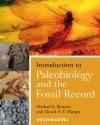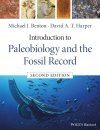Textbook
By: Michael J Benton(Author), David AT Harper(Author)
642 pages, 300 colour & b/w photos and colour & b/w illustrations, colour tables
![Introduction to Paleobiology and the Fossil Record Introduction to Paleobiology and the Fossil Record]()
Click to have a closer look
About this book
Contents
Customer reviews
Biography
Related titles
About this book
This book presents a comprehensive overview of the science of the history of life. Palaeobiologists bring many analytical tools to bear in interpreting the fossil record and Introduction to Paleobiology and the Fossil Record introduces the latest techniques, from multivariate investigations of biogeography and biostratigraphy to engineering analysis of dinosaur skulls, and from homeobox genes to cladistics.
All the well-known fossil groups are included, including microfossils and invertebrates, but an important feature is the thorough coverage of plants, vertebrates and trace fossils together with discussion of the origins of both life and the metazoans. All key related subjects are introduced, such as systematics, ecology, evolution and development, stratigraphy and their roles in understanding where life came from and how it evolved and diversified.
Unique features of Introduction to Paleobiology and the Fossil Record are the numerous case studies from current research that lead students to the primary literature, analytical and mathematical explanations and tools, together with associated problem sets and practical schedules for instructors and students.
New to the 2019 revision of the second edition:
1. The text and figures have been updated throughout to reflect current opinion on all aspects.
2. Many 2000-2009 case studies have been replaced with examples from 2010-2015. In selecting case studies to illustrate the chapters, the authors have chosen examples where the story is strong and well illustrated, where the source paper is attractive and easy for enthusiastic undergraduates to read, and ideally where the work has been done by a young person, and these will be noted to show what Masters and PhD students, and young postdocs are doing. Case studies reflect a broad distribution internationally, and an equable spread by gender, emphasizing work by young women and citizens of developing countries.
3. The chapters on Macroevolution, Form and Function, Mass extinctions, Origin of Life, and Origin of Metazoans are entirely rewritten to reflect substantial advances that have been taking place.
Contents
Preface xi
1 Paleontology as a science 1
2 Fossils in time and space 22
3 Paleogeography and paleoclimates 57
4 Paleoecology
5 Taphonomy and the quality of the fossil record 79
6 Fossil form and function
7 Macroevolution and the tree of life 116
8 Biodiversity, extinction and mass extinction 137
9 The origin of life 183
10 Protists 204
11 Origin of the metazoans 234
12 The basal metazoans: sponges and corals 260
13 Spiralians 1: lophophorates 297
14 Spiralians 2: mollusks 326
15 Ecdysozoa: arthropods 361
16 Deuterostomes: echinoderms and hemichordates 389
17 Fishes and basal tetrapods 427
18 Dinosaurs and mammals 453
19 Fossil plants 479
20 Trace fossils 509
Glossary 554
Appendix 1: Stratigraphic chart 573
Appendix 2: Paleogeographic maps 575
Index 576
Customer Reviews
Biography
Michael J. Benton is Professor of Vertebrate Palaeontology at the University of Bristol. He is interested particularly in early reptiles, Triassic dinosaurs and macroevolution, and has published 50 books and 160 scientific articles.
David Harper is a leading expert on fossil brachiopods and numerical methods in palaeontology. He is Professor of Palaeontology in the University of Copenhagen, where he is currently Head of Geology in the Natural History Museum of Denmark. He has published over 10 books and monographs, including a couple of influential textbooks, as well as over 250 scientific articles and, together with Oyvind Hammer, the widely-used software package PAST. His time is divided between collection management, exhibition work, research and some teaching.
Textbook
By: Michael J Benton(Author), David AT Harper(Author)
642 pages, 300 colour & b/w photos and colour & b/w illustrations, colour tables
Reviews of the 2009 second edition:
"The sheer scope of the book is a marvel. The easily accessible English which has been employed by the authors makes this book a sure-fire hit for anyone with a basic grasp of palaeontology and who needs to acquire an authoritative overview of the seemingly disparate parts of the subject. Introduction to Paleobiology and the Fossil Record is therefore perfect for undergraduate and postgraduate students of palaeontology; however, it will also endear it to anybody with a palaeontological background or interest. It is an outstanding contribution and in my opinion a must for all."
– Geological Journal, August 2010
"This book provides an excellent introduction to the study of paleobiology for advanced students in paleontology, evolutionary biology, and related fields."
– Choice, February 2009
"[...] any serious student of geology who does not pick this book off the shelf will be putting themselves at a huge disadvantage. The material may be complex, but the text is extremely accessible and well organized, and the book ought to be essential reading for palaeontologists at undergraduate, postgraduate and more advanced levels – both in Britain as well as in North America."
– Proceedings of the Geologists' Association, 2010
"This is an excellent introduction to palaeontology in general. It is well structured, accessibly written and pleasantly informative [...] I would recommend this as a standard reference text to all my students without hesitation."
– Geological Magazine, 2010
"This is the best paleontology textbook on the market today. It is a sure bet to set young students on the right path, and provides the 'long' answer to the question 'What should I study?'"
– The Quarterly Review of Biology, March 2010
"This undergraduate level college textbook presents a comprehensive overview into the science of paleobiology, and the many analytical tools and latest techniques used to interpret the fossil record."
– The Birdbooker Report, February 2009
"This book gives a competent, comprehensive and easy readable overview of all aspects of palaeontology and palaeobiology, which can be highly recommend to all, who are interested in the record of life from the beginning."
– Geological Survey of Austria, December 2008



































